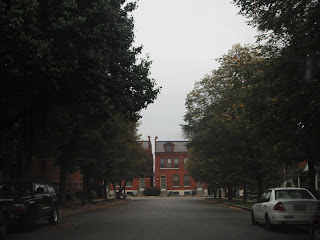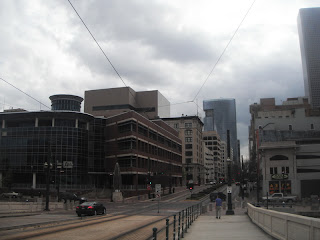Several weeks ago I explored one of the most obvious
consequences of the veritable implosion of the commercial airline
industry. After several years of
declining enplanements and repeated consolidations of the major airlines, we will
inevitably confront many manifestations of what I saw at Cleveland-Hopkins
International Airport: virtually an entirely vacant concourse.
This blog article on CLE's emptiness generated a fair amount of discussion on social media, with
others pointing out similar vacancies in airports such as Cincinnati,
Milwaukee, and St. Louis. CLE might
not be the greatest example, since the metro has suffered quite a bit more than
the average metro: both the city and suburbs lost population over the last few
decade. Even the most superficial
application of the inverse of the multiplier effect would lead to the
conclusion that demand for flights out of CLE is lower than it was in 2000;
after all, metro Cleveland has fewer people than it did ten to fifteen years
ago. But even metros with vigorous
job/population growth have experienced a similar predicament.
The photo above shows the first check-in/baggage claim
station at Indianapolis International Airport (IND). To the best of my memory, it was fully operative a year ago,
hosting passenger services for Delta.
Now it appears almost completely empty, with the exception of “Airline
Charter Services” (indicated by the perfunctory sign), but apparently that
isn’t active enough to justify the self-service check-in computer kiosks that we
would normally see. The
Indianapolis Airport Authority removed those when Delta left. And this isn’t the only check-in
station with vacant space:
Neither US Airways nor American Airlines are using all of
the check-in computers available at their respective stations, as indicated by
the fact that their logos do not stretch across the back wall. Instead, Visit Indy (formerly the
Indianapolis Convention and Visitors Association) fills the remaining space
with skyline and streetscape photos.
Naturally, one could rebut, “What if US Airways really is
using the entire check-in counter from end to end, and Visit Indy just wanted a
little room for self-promotion?” I
grant that could be true, but it wouldn’t explain why Delta’s new location
doesn’t have any Visit Indy placards:
Apparently, even in its new location, Delta is using its
entire counter. Compare each of
the aforementioned airlines to Frontier’s dinky space:
Again, I apologize for the terrible photo quality, but
Frontier only occupies the section with the green placards to the right side of
the photo. The remaining 75% of
that station consists of more “Visit Indy” signage—i.e., completely
vacant. Granted, Frontier Airlines
is much smaller than the others.
But further contraction is on the horizon: after all, US Airways has
bought out the bankrupt American, and last month a US Bankruptcy Court approved their eventual merger.
If the administrative space claimed by various airlines at
IND recedes this visibly in the public sections of the airport, one can only
imagine what’s taking place in the sections that are off limits to general
passengers. It is reasonable to
assume that the merger between US Airways and American will significantly
reduce the staffing needs by close to 50%, so the back-of-the-house sections of
the airport are probably going to look much the same as the photo below.
Hardly a soul arriving at the airport at 9pm on a Friday
night. Although the FAA classifies it as a medium hub, IND’s annual average of approximately 3.7 enplanements (nearly
a million fewer than CLE) would by most considerations rank it as a third-tier
airport, at least in terms of passenger traffic.
By the time of night that I took the photos, the majority of the airport’s storefronts
are typically closed. It’s just
never a terribly busy airport.
Like Cleveland’s Hopkins International Airport, it would
appear that IND has a glut of unused space that is only likely to grow after
the US Airways-American merger that will eventually form the world’s largest
airline. But two other factors
that distinguish IND from CLE only amplify the mismatch between our airports’
sizes and our ability to fill them.
First of all, metro Indianapolis is generally growing at a robust clip:
Urbanophile blogger Aaron Renn recently pointed out that
BLS metrics placed Indy at number
10 in the nation for job growth (2.84% from 2011 to 2012) after some sluggish
previous years. Cleveland’s 1.54%
over the same time period ranks it at the middle of the pack among large
metros. However, since the interval years are mismatched (FAA stats for 2012
aren’t available until July), I must draw from a 2010-2011 BLS report on metro job growth to form some broad-brush conclusions.
Incidentally, a cross-referencing between BLS employment growth and FAA
enplanements from 2010 to 2011 reveals little to no correlation between job
growth and shifts in passenger traffic.
For example, Louis Armstrong New Orleans International Airport (MSY)
enjoyed a solid growth in enplanements of 4.07% from 2010 to 2011, even though the
metro’s job growth has been negative during that time frame. Meanwhile, CLE declined in enplanements
at about the same rate (-4.14%), yet metro Cleveland’s job growth, though
modest, was positive. Apparently, any
change in metropolitan employment numbers offers no indication of the
respective airport’s vitality.
The other factor distinguishing IND from CLE—and virtually
all other major American airports for that matter—is that IND is operating out
of a brand new terminal. The
Colonel H. Weir Cook Terminal finished construction in November 2008—the first designed and built in the US since the September 11, 2001 attacks.
While few major airports are taking such radical steps as IND did several years
ago, the New York Times reported last year that many of the largest airports are undergoing significant renovations or expansions, particularly at the major international gateways, in order to
keep up with the amenities and services offered at the most prominent overseas
competitors.
An article as facile as this could hardly justify a critique
on airport renovations at LAX, ATL, or JFK—after all, none of the second- and
third-tier airports scrutinized in this article are facing the sort of
international passenger traffic as the big guys. But the emptiness at the smaller airports doesn’t auger well
for what might transpire at the big ones; after all, even though Atlanta and
JFK boast an array of other airlines that will buffer the impact of the US
Airways-American merger, this latest absorption of an airline is still likely
to free up at least a few baggage claim terminals, gates, and office
space. The ongoing trends in
airline mergers and diminished passenger travel may not have an impact on
infrastructural improvements taking place at airports, but it should seriously
call into question the need for any major expansions. And what airport authority would sensibly build a brand new
terminal in these times of dearth?!
Although airport construction does not depend on taxpayer money—the
local authorities finance capital improvements through the revenue they
generate in passenger fees—the leadership of these businesses must account for
their decisions through as consistent profitability as possible. And it’s hard to imagine airports like
CLE, IND, or MSY being able to justify any further upgrades, when their
terminals have devolved into echo chambers that host a floundering industry.
























































